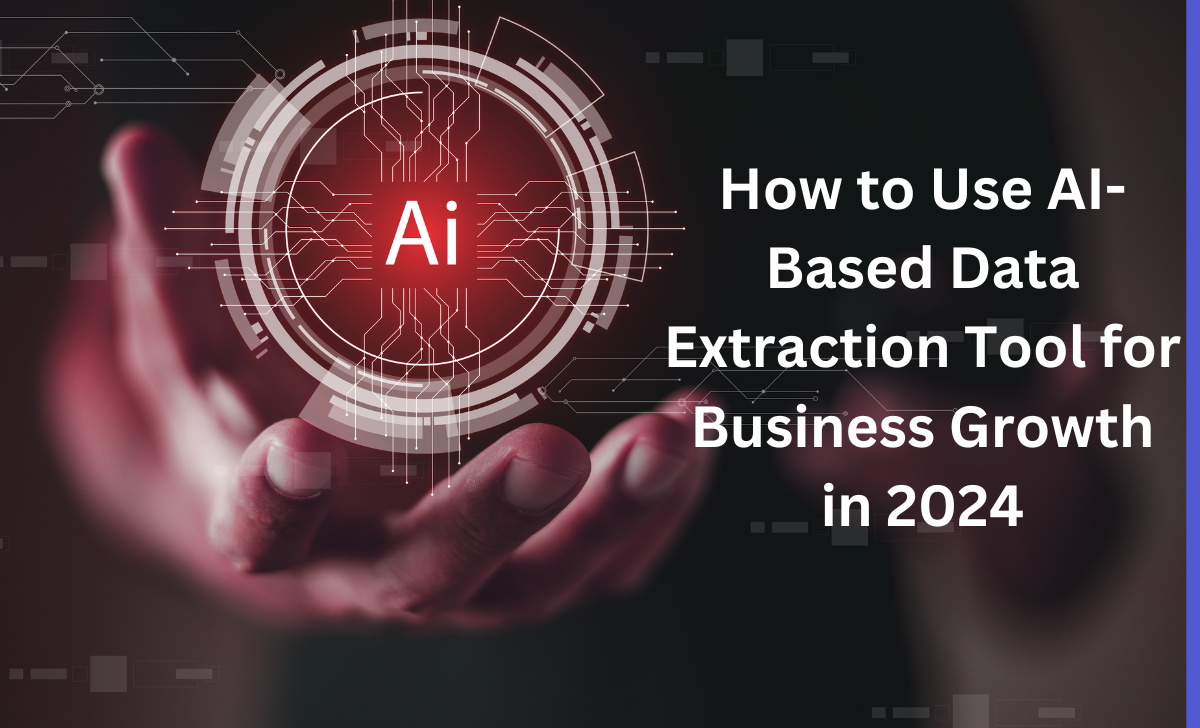|
Listen Now Our Blog Podcast
Getting your Trinity Audio player ready...
|
How to Use AI-Based Data Extraction Tools for Business Growth in 2024
In the fast-moving business world, leveraging cutting-edge technologies is key to staying ahead of the competition. One such technological marvel that has revolutionized the way companies manage and utilize data is Artificial Intelligence (AI).
In this article, we will explore the intricacies of using AI-based data extraction tools to drive business growth. From understanding the basics to choosing the right tool and implementing it effectively, this comprehensive guide aims to provide actionable insights for businesses of all sizes.
I. Introduction
Overview of AI in Business
Artificial Intelligence has evolved from a futuristic concept to a practical tool driving business innovation. Businesses across industries are recognizing the transformative potential of AI, and data extraction is at the forefront of this revolution.
Importance of Data Extraction
Efficient data extraction is the cornerstone of informed decision-making. AI-based tools take this process to new heights by automating mundane tasks and extracting valuable insights, enabling businesses to make data-driven decisions swiftly.
II. Understanding AI-Based Data Extraction
Definition and Basics
At its core, AI-based data extraction involves utilizing machine learning algorithms to identify, extract, and organize data from various sources. This process eliminates the need for manual data entry, reducing errors and saving valuable time.
Role in Business Intelligence
The marriage of AI and data extraction amplifies the capabilities of Business Intelligence (BI). By automating the extraction of relevant information, businesses can unlock deeper insights, facilitating strategic planning and forecasting.
Types of Data Extracted
AI-based tools can extract a myriad of data types, including structured, semi-structured, and unstructured data. This versatility allows businesses to harness insights from diverse sources, from databases to emails and documents.
III. Choosing the Right AI Data Extraction Tool
Considerations for Selection
Selecting the right AI data extraction tool requires a strategic approach. Consider factors such as the specific needs of your business, scalability, ease of integration, and the tool’s ability to adapt to evolving data formats.
Key Features to Look For
Look for features that align with your business objectives, such as intelligent document processing, natural language processing, and the ability to handle complex data structures. A user-friendly interface and robust support are also crucial considerations.
Comparing Popular Tools in the Market
A thorough comparison of popular AI data extraction tools in the market is essential. Evaluate user reviews, case studies, and the track record of each tool to make an informed decision tailored to your business requirements.
IV. Implementing AI Data Extraction in Your Business
Integration Process
The integration of AI data extraction tools into your existing infrastructure requires careful planning. Work closely with your IT team to ensure a seamless integration that minimizes disruptions to ongoing operations.
Compatibility with Existing Systems
Ensure that the selected tool is compatible with your existing systems and software. This compatibility is crucial for a smooth transition and ongoing collaboration between AI tools and other business applications.
Training Your Team on AI Tools
A successful implementation goes beyond technology—it involves empowering your team with the necessary skills. Invest in comprehensive training programs to ensure that your staff can effectively utilize the capabilities of AI-based data extraction tools.
V. Enhancing Data Accuracy and Quality
Role of AI in Minimizing Errors
AI excels at repetitive tasks, reducing the likelihood of errors associated with manual data extraction. By automating the process, businesses can enhance accuracy and reliability, laying the foundation for informed decision-making.
Ensuring Data Consistency
Consistency is paramount in data management. AI tools enforce consistency by applying predefined rules to data extraction, ensuring uniformity across various datasets and minimizing discrepancies.
Quality Control Measures
Implement robust quality control measures to validate extracted data. Regular audits and checks will help identify and rectify any discrepancies, maintaining the integrity of your data and bolstering confidence in decision-making processes.
VI. Leveraging AI for Efficient Workflows
Automation Benefits
AI-based data extraction automates repetitive tasks, freeing up valuable human resources for more strategic activities. This leads to increased efficiency, reduced turnaround times, and a more streamlined workflow.
Streamlining Business Processes
Identify bottlenecks in your existing processes and leverage AI tools to streamline workflows. From invoice processing to customer data management, AI can optimize various business processes, boosting overall operational efficiency.
Case Studies of Successful Implementations
Explore real-world examples of businesses that have successfully leveraged AI for workflow optimization. Case studies provide insights into the practical benefits and tangible results achieved by integrating AI-based data extraction tools.
VII. Security Measures in AI-Based Data Extraction
Ensuring Data Privacy
With the increasing emphasis on data privacy, it’s crucial to choose AI tools that prioritize and adhere to stringent privacy standards. Understand the data handling processes of your chosen tool and ensure it aligns with your organization’s privacy policies.
Cybersecurity Considerations
AI tools can be vulnerable to cybersecurity threats. Implement robust cybersecurity measures to safeguard sensitive information extracted by these tools, protecting your business and customer data from potential breaches.
Compliance with Regulations
Stay abreast of data protection regulations and ensure that your AI data extraction practices comply with regional and industry-specific requirements. This not only mitigates legal risks but also builds trust among stakeholders.
VIII. Overcoming Challenges in AI Data Extraction
Common Issues and Solutions
Anticipate and address common challenges associated with AI data extraction, such as misinterpretation of unstructured data or integration issues. Having contingency plans and proactive solutions in place will help minimize disruptions.
Continuous Improvement Strategies
AI is an evolving field, and continuous improvement is essential. Implement strategies for ongoing optimization, regularly update algorithms, and stay informed about advancements in AI technology to maintain peak performance.
Industry Best Practices
Learn from industry leaders and adopt best practices in AI data extraction. Collaborate with experts, attend conferences, and stay connected with industry forums to stay informed about the latest trends and innovations.
IX. Realizing Cost Savings with AI Tools
Reducing Manual Workloads
By automating data extraction, businesses can significantly reduce the need for manual data entry and processing. This not only saves time but also cuts down on labor costs, allowing organizations to allocate resources more efficiently.
Improving Resource Allocation
Allocate human resources strategically by automating routine tasks. Redirect skilled personnel toward higher-value activities that require creativity, critical thinking, and complex decision-making, enhancing overall productivity.
Long-term Financial Impact
Assess the long-term financial impact of implementing AI data extraction tools. Consider not only the upfront costs but also the potential for increased revenue, cost savings, and improved decision-making contributing to the overall financial health of the business.
X. Future Trends in AI Data Extraction
Emerging Technologies
Explore emerging technologies shaping the future of AI data extraction, such as advanced machine learning algorithms, neural networks, and natural language processing enhancements. Stay ahead by understanding the potential impact on your business.
Anticipated Developments
Stay informed about anticipated developments in AI data extraction. From improved accuracy to faster processing speeds, understanding upcoming advancements will help your business proactively adapt to the evolving landscape.
Staying Ahead in a Dynamic Landscape
Position your business to stay ahead by fostering a culture of innovation. Encourage collaboration between your IT and data science teams, and invest in ongoing education to ensure your organization remains at the forefront of technological advancements.
XI. Case Studies: Success Stories with AI Data Extraction
Exemplary Business Transformations
Explore case studies showcasing businesses that experienced significant transformations through the implementation of AI data extraction tools. Understand the challenges they faced, the solutions implemented, and the tangible outcomes achieved.
Measurable Results
Highlight the measurable results achieved by businesses, such as increased productivity, reduced error rates, and enhanced decision-making capabilities. Quantify the impact of AI data extraction on key performance indicators.
Lessons Learned
Extract valuable lessons from the experiences of other businesses. Understand the common pitfalls, success factors, and lessons learned throughout the implementation process to inform and guide your own strategy.
XII. Training Your Team for AI Integration
Importance of Employee Training
Acknowledge the importance of training your team for successful AI integration. Empower your employees with the skills and knowledge necessary to maximize the potential of AI data extraction tools.
Skill Development Initiatives
Invest in skill development initiatives tailored to your business needs. This may include workshops, online courses, and hands-on training sessions to ensure that your team is well-equipped to navigate the complexities of AI tools.
Building a Data-Driven Culture
Cultivate a data-driven culture within your organization. Encourage a mindset that values data as a strategic asset, fostering an environment where employees understand the impact of data on decision-making processes.
XIII. Measuring ROI on AI Data Extraction
Establishing Key Performance Indicators (KPIs)
Define key performance indicators aligned with your business goals. Whether it’s increased efficiency, improved data accuracy, or cost savings, establish measurable metrics to gauge the return on investment in AI data extraction.
Quantifying Business Improvements
Quantify the improvements brought about by AI tools. Use data to showcase how these tools have positively impacted your business, providing tangible evidence of their contribution to organizational success.
Long-term Return on Investment
Assess the long-term return on investment by analyzing the cumulative impact of AI data extraction over time. Consider the evolving needs of your business and how AI tools continue to deliver value in the long run.
Gradual Rollout Strategies
XIV. Tips for Scaling AI Implementation
Implement AI data extraction tools gradually to allow for smooth integration and minimal disruption. Consider starting with pilot projects before scaling up to larger and more complex implementations.
Monitoring Scalability Challenges
Be vigilant about scalability challenges as your business grows. Regularly assess the performance of AI tools and evaluate their scalability to ensure they can handle increasing data volumes and evolving business requirements.
Adapting to Growing Business Needs
AI implementation should be flexible enough to adapt to the evolving needs of your business. Regularly review and adjust your AI strategy to align with changing business objectives, ensuring continued relevance and effectiveness.
XV. Addressing Ethical Considerations in AI
Responsible Data Usage
Emphasize responsible data usage practices within your organization. Establish ethical guidelines for handling sensitive information and ensure that your AI data extraction tools adhere to ethical standards in data processing.
Fair and Transparent Practices
Promote fairness and transparency in AI algorithms. Understand and communicate how AI tools make decisions, ensuring that your business practices align with principles of fairness and transparency in data processing.
Ethical AI Policies for Your Business
Develop and implement ethical AI policies specific to your business. These policies should outline the ethical considerations, guidelines for data usage, and mechanisms for addressing ethical concerns that may arise in AI data extraction processes.
XVI. Continuous Learning and Adaptation
Keeping Abreast of Technological Advancements
Encourage a culture of continuous learning within your organization. Stay informed about the latest technological advancements in AI and data extraction, fostering an environment where employees are eager to embrace new technologies.
Adaptive Strategies for Changing Business Environments
Develop adaptive strategies to navigate changing business environments. Consider the evolving landscape of your industry, market trends, and technological advancements, and adjust your AI data extraction strategy accordingly.
Fostering Innovation in Data Management
Promote innovation in data management by encouraging creative thinking and exploration of new approaches. Create avenues for collaboration between data scientists, analysts, and business stakeholders to drive innovative solutions in data extraction.




